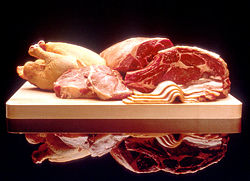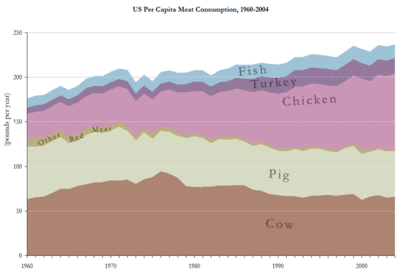Meat
2008/9 Schools Wikipedia Selection. Related subjects: Food
Meat, in its broadest definition, is animal tissue used as food. Most often it references to skeletal muscle and associated fat, but it may also refer to non- muscle organs, including lungs, livers, skin, brains, bone marrow and kidneys. The word meat is also used by the meat packing and butchering industry in a more restrictive sense - the flesh of mammalian species (pigs, cattle, etc.) raised and butchered for human consumption, to the exclusion of fish, poultry, and insects. Eggs are rarely referred to as meat even though they consist of animal tissue. Animals that consume only meat are carnivores.
The meat packing industry slaughters, processes, and distributes meats for human consumption in many countries.
Etymology
The word meat comes from the Old English word mete, which referred to food in general. Mad in Danish, and mat in Swedish and Norwegian, still mean food. The narrower sense, referring exclusively to animal flesh developed over the past few hundred years. Until recently, meaty continued to often be used to refer to any food of a "meaty" consistency—the meat of an artichoke, for example. This usage is mostly obscure today, but the word can still be used to imply reference to the most essential or substantial part of something (e.g., "the real meat of the government's policies...").
Meaty also shares some of the sexual connotations that flesh carries, and can be used to refer to the human body, often in a way that is considered vulgar or demeaning, as in the phrase meat market, which, in addition to simply denoting a market where meat is sold, can also be a slang phrase referring to a place or situation where humans are treated or viewed as commodities, especially a place where one looks for a casual sexual encounter. This sexual connotation has also existed for at least 500 years.
Methods of preparation
Meat is prepared in many ways, as steaks, in stews, fondue, or as dried meat. It may be ground then formed into patties (as burgers or croquettes), loaves, or sausages, or used in loose form (as in "sloppy joe" or Bolognese sauce). Some meats are cured, by smoking, pickling, preserving in salt or brine (see salted meat and curing). Others are marinated and barbecued, or simply boiled, roasted, or fried. Meat is generally eaten cooked, but there are many traditional recipes that call for raw beef, veal or fish. Meat is often spiced or seasoned, as in most sausages. Meat dishes are usually described by their source (animal and part of body) and method of preparation.
Meat is a typical base for making sandwiches. Popular sandwich meats include turkey, chicken, ham, pork, bacon, salami and other sausages, and beef, such as steak, roast beef, corned beef, and pastrami. Meat can also be molded or pressed (common for products that include offal, such as haggis and scrapple) and canned.
Nutritional benefits and concerns
All muscle tissue is very high in protein, containing all of the essential amino acids. Muscle tissue is very low in carbohydrates. The fat content of meat can vary widely depending on the species and breed of animal, the way in which the animal was raised including what it was fed, the anatomical part of its body, and the methods of butchering and cooking. Wild animals such as deer are typically leaner than farm animals, leading to the increasing popularity of game such as venison; however, centuries of breeding meat animals for size and fatness is being reversed by consumer demand for meat with less fat. Animal fat is relatively high in saturated fat and cholesterol, which have been linked to various health problems, including heart disease and arteriosclerosis.
| Source | calories | protein | carbs | fat |
|---|---|---|---|---|
| fish | 110–140 | 20–25 g | 0 g | 1–5 g |
| chicken breast | 160 | 28 g | 0 g | 7 g |
| lamb | 250 | 30 g | 0 g | 14 g |
| steak (beef) | 275 | 30 g | 0 g | 18 g |
| T-bone | 450 | 25 g | 0 g | 35 g |
The table at right compares the nutritional content of several types of meat. While each kind of meat has about the same content of protein and carbohydrates, there is a very wide range of fat content. It is the additional fat that contributes most to the calorie content of meat, and to concerns about dietary health. A famous study, the Nurses' Health Study, followed about one-hundred-thousand female nurses and their eating habits. Nurses who ate the largest amount of animal fat were twice as likely to develop colon cancer as the nurses who ate the least amount of animal fat.
In response to health concerns about saturated fat and cholesterol, consumers have altered their consumption of various meats. A USDA report points out that consumption of beef in the United States between 1970–1974 and 1990–1994 dropped by 21%, while consumption of chicken increased by 90%.
Meat can transmit certain diseases. Undercooked pork sometimes contains the parasites that cause trichinosis or cysticercosis. Chicken is sometimes contaminated with Salmonella enterica disease-causing bacteria. The recent outbreak of bird flu has stimulated global concerns over public health. Cattle tissue occasionally contains the prions that cause variant Creutzfeldt-Jakob Disease. Practice of good food safety and animal husbandry practices reduces most of these risks. These are almost never a factor in the consumption of wild meats.
Abstention from meat
People may abstain from consuming meat for a variety of reasons.
Cultural and religious taboos
Cultural taboos inhibit the consumption of certain kinds of meat, even for non-religious people. For example, consumption of human meat, or cannibalism, is nearly always considered a cultural taboo.
Some cultures do not eat the meat of animals species that they regularly keep as pets. In Western Culture, rabbits and fish are exceptions to this rule.
Islam and Judaism both have dietary laws. Halal is the term that refers to Islamic dietary laws and Kashrut is the term that refers to Jewish dietary laws.
In vitro and imitation meat
Various forms of imitation meat have been created to satisfy some vegetarians' taste for the flavor and texture of meat, and there is speculation about the possibility of growing in vitro meat from animal tissue.



